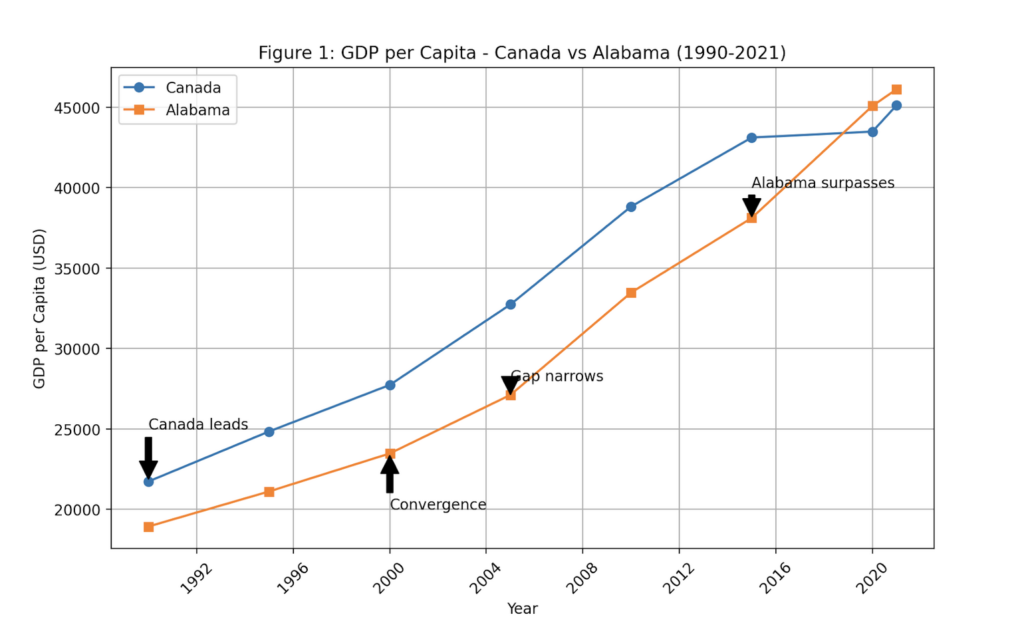
Who would’ve guessed that sleepy ol’ Alabama passed Canada’s GDP per capita?
It seems almost unbelievable―how did Canada, long considered one of the world’s most prosperous and stable economies, end up with a GDP per capita surpassed by Alabama, a state not typically associated with economic might?
However, the numbers don’t lie: Surprising new data points reveal Canada’s economic competitiveness has declined significantly in recent years.
According to data from the World Bank and Organization for Economic Co-operation and Development (OECD), Alabama passed Canada’s GDP per capita in 2019 and now Canada has fallen below the level of Alabama, usually considered the poorest state in the United States.
While Canadians may scoff in disbelief at the comparison, it merits a deeper examination of what factors have contributed to this role reversal between Canada and America’s once poorest state. This article will explore the underlying drivers of how Alabama passed Canada’s GDP per capita. We’ll focus on the brain drain of skilled workers, challenges with innovation, and government policies that have arguably held back business growth.
Through analyzing GDP trends and speaking with experts, I aim to offer insight for anyone thinking about coming into Canada about Canada’s shifting financial position while also revealing lessons that could be learned from Alabama’s economic trajectory. So without further waiting, let’s dive into why and how Alabama passes Canada in GDP!
Looking to Leave the USA?
Check out the USA Exit Guide Today! See how to leave the USA legally, quickly, and properly without heavy tax burdens.

Historical Context
To understand how matters have arrived at this curious juncture, it’s necessary to take a step back and review Canada’s economic path. For much of the late 20th century, Canada enjoyed relatively strong economic performance compared to other developed nations.
Canada’s Years of Prosperity: 1970 – 1990
We rode high on waves of prosperity throughout the 1970s and 80s, with GDP per capita regularly exceeding that of the US. However, a series of policy missteps beginning in the 1990s started undermining Canada’s competitiveness. After backing out of the free trade agreement with the US in the 1980s, Canada lost significant foreign investment that went south instead.
The New Century Stagnation: 1991 – 2009
In the new century, high taxes and rising energy costs made Canada a less attractive place to do business. And while globalization and technological change disrupted many traditional industries—Canada appeared slow to adapt. Investments in new areas like cleantech and biotech lagged behind other nations.
Alabama Passed Canada’s GDP: 2010 – 2024
Meanwhile, our neighbors to the south took charge of tax cuts and deregulation, fueling business growth. By the 2010s, Canada’s GDP per person had fallen significantly below average American levels, setting the stage for Alabama to pass Canada’s GDP.
As for Alabama, the state has a history of economic struggles. Once reliant on declining sectors like textiles and steel production, Alabama in the 1980s had one of the lowest GDPs per capita nationwide. However, strategic recruitment of automotive plants and aerospace companies transformed the manufacturing landscape. Combined with individual tax cuts under the Republican administration, GDP rose steadily through the 2000s to the point that by 2022, Alabama edged ahead of Canada on a per capita basis, according to the World Bank data.
Comparative Analysis of GDP
To visualize when Alabama passed Canada’s GDP per capita take a look at the chart below. Figure 1 plots GDP per capita in Canada and Alabama from 1990 to 2022 using statistics from the U.S. Bureau of Economic Analysis and World Bank. The graph tells an intriguing story. Throughout the early 1990s, Canada’s GDP per person held a sizable lead over Alabama’s, reflecting the former’s stronger economy.

However, the lines began to converge later in the decade as Alabama gained manufacturing jobs. By 2005, the gap had nearly closed. Then, in the 2010s, Alabama’s line climbed above Canada’s, cementing the role reversal.
What allowed for Alabama’s economic rise? Tax incentives are believed to have played a key part. The state offers some of the lowest corporate rates nationwide, and individual income taxes were slashed in 2018.
Combined with the strategic recruitment of aerospace giant Airbus and automakers like Hyundai through generous incentive packages, manufacturing jobs surged. This helped because Alabama passed Canada’s GDP per capita in early 2019. Furthermore where corporate taxes remain higher and manufacturing employment has shrunk. Of course, other underlying factors on both sides also contributed to the changing fortunes, which we will explore further.
Factors Behind Canada’s Economic Odyssey
After looking at that graph you’re probably wondering: “How did a once prosperous country fall below America’s one poorest state in per capita GDP?” In this segment we will explore how Alabama passed Canada’s GDP and what you can do about it.
1. Brain Drain: The Escape of the Smarties
Brain drain is the phenomenon of skilled and educated workers leaving a country or region for better opportunities elsewhere. Brain drain can have negative effects on the economy, such as reducing human capital, innovation, and tax revenues.

Canada has experienced a brain drain for decades, especially to the United States, which offers higher wages, larger markets, and more funding for research and development. The peak of the brain drain occurred at the turn of the century when Canada lost thousands of doctors, engineers, scientists, and entrepreneurs to the United States.
Rumor has it you can now find more Canadian PhDs per capita in Silicon Valley than in all of Newfoundland. Even Canadian inventors have realized their bright ideas have better odds of success if crossed below the Medicine Line. With the nation’s best and brightest pulling a Houdini act, is it any wonder the Great White North has been outsmarted?
Many cite higher wages and a more business-friendly environment as reasons for their move. Experts note this drain of top talent hinders Canada’s innovation potential and GDP growth over time. To better understand why Canadians are leaving, I spoke to Andrew Chen, a 33-year-old AI researcher who moved from Toronto to San Francisco in 2018.
“The opportunities and salaries in tech just seemed limitless in Silicon Valley compared to Canada. Rent and cost of living is higher but quality of life has improved with the warmer weather and access to better funded startups, “ he said. “What’s most puzzling is that Canada produces world-class AI talent but our governments don’t do enough to retain that skills within the country.”
– Andrew Chan, AI Researcher & Torontonian living in San Francisco
2. Innovation Challenges: Where Ideas Go to Hibernate
While our neighbors effortlessly churn out innovations, Canada seems stuck in a deep slumber. In the innovation hibernation nation, coming up with new ideas is about as likely as spotting a polar bear in the desert.
According to the Global Innovation Index 2023, a ranking of countries based on their innovation performance and environment, Canada ranked 16th in the world in 2023, behind the UK (3rd), the US (2nd), and Sweden (1st), among others.Certain high-growth industries have also struggled to take off in Canada.
The US remained the dominant market for AI funding, with $18.6 billion invested across 1,038 deals in 2023. Canada, on the other hand, saw a decline in AI funding, with only $216 million invested across 48 deals in 2023. This represents a 23% decrease from the $280 million invested in 2020.

The clean technology sector exemplifies Canada’s innovation challenges and shows how aven a poorer state like Alabama passed Canada’s GDP per capita. Despite early leadership in renewable energy, Canada has fallen from 4th globally in clean patents in 2010 to 11th in 2020. One factor driving this is the smaller size of Canada’s market, which limits scale-up opportunities for new firms.
Frank Rotman, a partner at US-based venture capital firm Kodiak Ventures, notes that “Canada is at a disadvantage compared to major tech hubs because it doesn’t have their depth of risk capital or network effects. Startups struggle to find later stage funding required to truly compete internationally. This makes Canada a great place to be an early-stage startup but less attractive as they mature.” Without adequate policy support, Canada risks missing out on the high-paying jobs and export revenues of tomorrow’s globally dominant industries.
3. Unusual Government Policies
High personal and corporate income taxes compared to nations like the US reduce Canada’s competitiveness. And the economic policies pursued by Canada and Alabama could not be more polar. While Ottawa has flirted with every ideology from Keynesian to Reaganomics, Alabama seems to stick to what works—good old-fashioned supply-side policies.
In Canada, it feels like every week brings a new business subsidy, green energy plan, or trial basic income program. And companies must keep a spreadsheet just to comply with the latest regulations. With politicians constantly shifting priorities like psychedelic air traffic controllers, it’s remarkable anything gets done.
Meanwhile, down South, they keep it simple—low taxes, limited red tape, and get out of the way. Businesses face a light touch and stability to plan ahead, unlike poor Canadian firms left guessing from one political whim to another. Is it any wonder why Alabama passed Canada’s GDP per capita like a phoenix from the ashes of America’s Deep South?
Expert Insights & Possible Solutions
Economists have been scratching their heads over Canada’s economic crisis for years. Brain drain and lack of scale are cited as drags on productivity.
“All the smart folks hopped the border years ago, leaving behind the slow kids,”
– Queen’s expert Seymour Buttz says jokingly.
While not all experts agree, most diagnose the cause as too much tinkering without understanding the side effects. As we all know, nothing throws a wrench in innovation quicker than policy inconsistency. If Canada wants to lead the global growth pack again, it may be time for some self-reflection on decades of economic odysseys gone awry.
To stem the brain drain exodus, extreme measures are on the table. “We could build a wall and make the US pay! Or start a viral TikTok campaign ‘Why Leave Canada?’ set to catchy hip hop,” muses junior minister Justin Trudeau the Third.
More practically, experts call for tax code changes and funding mechanisms to maximize economic potential. Also, experts advocate R&D credits, tax breaks for hiring PhDs, and partnering schools with industry. “It’s about creating an ecosystem where talented youth see exciting local opportunities, not an airport,” notes Waterloo’s Iain Klugman.
On fostering innovation, suggestions include special economic zones with relaxed regulations, increased VC funds matching private dollars, and crowdsourcing national innovation challenges à la Elon Musk. The goal? Make Canada the world’s sandpit for crazy ideas again.
Looking to leave Canada?
Take the country quiz to see where you belong!
Wrapping Up
And so we see how Alabama passed Canada’s GDP per capita and how Canada tumbled from an economic epicenter to being outdone by a state known mainly for its sweet tea and seersucker suits. But with youth, initiative, and innovation, there remains hope the True North, strong and prosperous, may reclaim its place by addressing brain drain, boosting business, and reinvigorating R&D while stabilizing prudent policies, a brighter era could dawn!


Leave a Reply